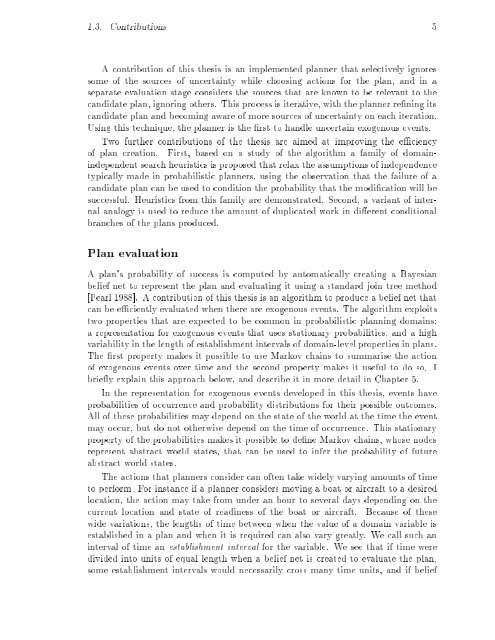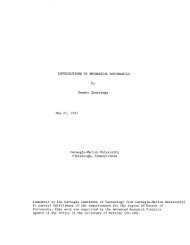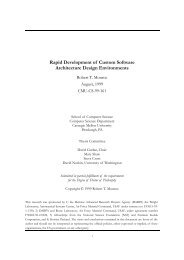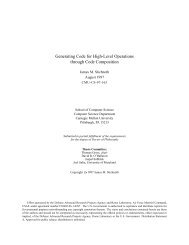Planning under Uncertainty in Dynamic Domains - Carnegie Mellon ...
Planning under Uncertainty in Dynamic Domains - Carnegie Mellon ...
Planning under Uncertainty in Dynamic Domains - Carnegie Mellon ...
You also want an ePaper? Increase the reach of your titles
YUMPU automatically turns print PDFs into web optimized ePapers that Google loves.
1.3. Contributions 5A contribution of this thesis is an implemented planner that selectively ignoressome of the sources of uncerta<strong>in</strong>ty while choos<strong>in</strong>g actions for the plan, and <strong>in</strong> aseparate evaluation stage considers the sources that are known to be relevant to thecandidate plan, ignor<strong>in</strong>g others. This process is iterative, with the planner ren<strong>in</strong>g itscandidate plan and becom<strong>in</strong>g aware of more sources of uncerta<strong>in</strong>ty on each iteration.Us<strong>in</strong>g this technique, the planner is the rst to handle uncerta<strong>in</strong> exogenous events.Two further contributions of the thesis are aimed at improv<strong>in</strong>g the eciencyof plan creation. First, based on a study of the algorithm a family of doma<strong>in</strong><strong>in</strong>dependentsearch heuristics is proposed that relax the assumptions of <strong>in</strong>dependencetypically made <strong>in</strong> probabilistic planners, us<strong>in</strong>g the observation that the failure of acandidate plan can be used to condition the probability that the modication will besuccessful. Heuristics from this family are demonstrated. Second, a variant of<strong>in</strong>ternalanalogy is used to reduce the amount of duplicated work <strong>in</strong> dierent conditionalbranches of the plans produced.Plan evaluationA plan's probability of success is computed by automatically creat<strong>in</strong>g a Bayesianbelief net to represent the plan and evaluat<strong>in</strong>g it us<strong>in</strong>g a standard jo<strong>in</strong> tree method[Pearl 1988]. A contribution of this thesis is an algorithm to produce a belief net thatcan be eciently evaluated when there are exogenous events. The algorithm exploitstwo properties that are expected to be common <strong>in</strong> probabilistic plann<strong>in</strong>g doma<strong>in</strong>s:a representation for exogenous events that uses stationary probabilities, and a highvariability <strong>in</strong> the length of establishment<strong>in</strong>tervals of doma<strong>in</strong>-level properties <strong>in</strong> plans.The rst property makes it possible to use Markov cha<strong>in</strong>s to summarise the actionof exogenous events over time and the second property makes it useful to do so. Ibriey expla<strong>in</strong> this approach below, and describe it <strong>in</strong> more detail <strong>in</strong> Chapter 5.In the representation for exogenous events developed <strong>in</strong> this thesis, events haveprobabilities of occurrence and probability distributions for their possible outcomes.All of these probabilities may depend on the state of the world at the time the eventmay occur, but do not otherwise depend on the time of occurrence. This stationaryproperty of the probabilities makes it possible to dene Markov cha<strong>in</strong>s, whose nodesrepresent abstract world states, that can be used to <strong>in</strong>fer the probability of futureabstract world states.The actions that planners consider can often take widely vary<strong>in</strong>g amounts of timeto perform. For <strong>in</strong>stance if a planner considers mov<strong>in</strong>g a boat or aircraft to a desiredlocation, the action may take from <strong>under</strong> an hour to several days depend<strong>in</strong>g on thecurrent location and state of read<strong>in</strong>ess of the boat or aircraft. Because of thesewide variations, the lengths of time between when the value of a doma<strong>in</strong> variable isestablished <strong>in</strong> a plan and when it is required can also vary greatly. We call such an<strong>in</strong>terval of time an establishment <strong>in</strong>terval for the variable. We see that if time weredivided <strong>in</strong>to units of equal length when a belief net is created to evaluate the plan,some establishment <strong>in</strong>tervals would necessarily cross many time units, and if belief







